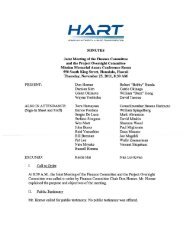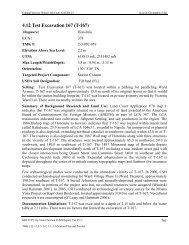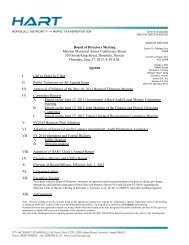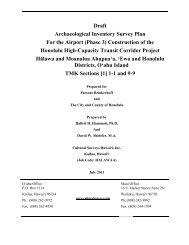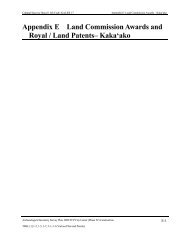AISP Kamehameha Highway Guideway - Honolulu Rail Transit Project
AISP Kamehameha Highway Guideway - Honolulu Rail Transit Project
AISP Kamehameha Highway Guideway - Honolulu Rail Transit Project
Create successful ePaper yourself
Turn your PDF publications into a flip-book with our unique Google optimized e-Paper software.
Cultural Surveys Hawai‘i Job Code: MANANA 1<br />
Background Research<br />
Section 2 Background Research<br />
2.1 Mythological and Traditional Accounts<br />
2.1.1 Place Names of Eastern ‘Ewa<br />
In 1873, S. K. Kuhano described the ancient O‘ahu land divisions. The island was as divided<br />
into 6 moku (districts), consisting of: Kona, ‘Ewa, Wai‘anae, Waialua, Ko‘olauloa and<br />
Ko‘olaupoko. These moku were further divided into 86 ahupua‘a (land division within a moku).<br />
‘Ewa was divided into 12 ahupua‘a, consisting of (from east to west): Hālawa, ‘Aiea, Kalauao,<br />
Waimalu, Waiau, Waimano, Mānana, Wai‘awa, Waipi‘o, Waikele, Hō‘ae‘ae and Honouliuli<br />
(Kame‘eleihiwa 1992:330). The current study area, located in eastern ‘Ewa, traverses the<br />
ahupua‘a of Waiawa, Mānana, Waimano, Waiau, Waimalu, Kalauao, ‘Aiea, and Hālawa (Figure<br />
7).<br />
2.1.1.1 Place Names along the Main Trail through the ‘Ewa District<br />
John Papa ‘Ī‘ī (1959:96-98) described a network of trails through Leeward O‘ahu, which in<br />
historic times encircled and traversed the Wai‘anae Range (Figure 8). The coastal trail, that<br />
connected ‘Ewa with the Kona District to the east and the Wai‘anae District to the west, ran<br />
along the inland boundary of the Pearl Harbor floodplain and irrigated taro fields of the<br />
ahupua‘a of eastern ‘Ewa. This coastal trail was described by ‘Ī‘ī, who was traveling from<br />
<strong>Honolulu</strong>, through the ‘Ewa District, and on to Wai‘anae:<br />
…From there the trail went to Kaleinakauhane [Moanalua Ahupua‘a in the Kona<br />
District], then to Kapukaki [Red Hill on the Moanalua / Hālawa boundary], from<br />
where one could see the irregular sea of Ewa; then down the ridge to Napeha [in<br />
Hālawa], a resting place for the multitude that went diving there at a deep pool.<br />
This pool was named Napeha (Lean Over), so it is said, because Kaulii, a chief of<br />
ancient Oahu, went there and leaned over the pool to drink water.<br />
The trail began again on the opposite side of the pool and went to the lowland of<br />
Halawa, on to Kauwamoa, a diving place and a much-liked gathering place. It was<br />
said to be the diving place of Peapea, son of <strong>Kamehameha</strong>nui of Maui who was<br />
swift in running and leaping. The place from which he dove into the water was 5<br />
to 10 fathoms above the pool.<br />
There the trail led to the taro patches in Aiea and up the plain of Kukiiahu. Just<br />
below the trail was the spot where Kaeo, chief of Kaua‘i, was killed by<br />
Kalanikupule. From there the trail went along the taro patches to the upper part of<br />
Kohokoho and on to Kahuewai [in Kalauao], a small waterfall. On the high<br />
ground above, a little way on, was a spring, also a favorite gathering place for<br />
travelers. From there it continued over a small plain down the small hill of<br />
Waimalu, and along the taro patches that lay in the center of the land…<br />
Archaeological Inventory Survey Plan, HHCTCP Construction Phase II, Waiawa, Mānana, Waimano, Waiau,<br />
Waimalu, Kalauao, ‘Aiea, and Hālawa Ahupua‘a, ‘Ewa District, Island of O‘ahu<br />
TMK[1] 9-7, 9-8, and 9-9 - Various Plats and Parcels<br />
14



